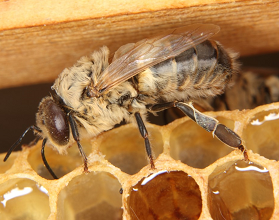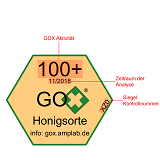Glucoseoxidase (GOX):
Quality characteristic of native honey
Honey isn’t just a popular food product; it is also part of many medicine cabinets and some medical products (e.g. Medihoney, Revamil). Honey’s healing effects on wounds have been proven in clinical trials, while other scientific examinations show that some honeys can act antibacterially, antivirally and fungicidally (Kwakman et al., 2011, Chen et al., 2012, Boukraa, 2014). This effect is of growing importance for the honey consument, especially in light of an increasing number of germs resistant to antibiotics. We saw the opportunity for consumers to be better informed about the remarkable antibacterial qualities of honey. We have therefore developed a test of the underlying enzyme activity potential of honey and a corresponding informational product seal.
Basis of the antibacterial effect:
Hydrogen peroxide (H2O2) is a part of both the immune system of humans and the social immune system of bees. Essential to the antibacterial effect of native honey is the ability to form H2O2 (Kwakman et al., 2010). This is supported by other non-peroxidic factors, e.g. pH value, Defensin-1, Polyphenols, Fe2+ (Brudzynski and Lannigan, 2012). New Zealandic and Australian monofloral Manuka honey, on the other hand, contains antibacterial methylglyoxal (MGO).
Bees add the enzyme glucose oxidase (GOX) to honey through their saliva, which then forms hydrogen peroxide and gluconolactone out of glucose and oxygen. The concentration at which H2O2 is antibacterially effective is already quite low (Linley et al., 2012). This is 100-1000 times lower than in antiseptic H2O2-solutions used in the food industry and medicine to sterilize surfaces, and can be achieved by appropriate dilution. Toxic concentrations for humans cannot be reached because the H2O2 production in diluted honey is limited by the enzyme’s kinetic properties (Bao et al., 2003). GOX is deactivated by dehydration of honey, but can then be reactivated by dilution of honey. The higher the GOX activity in a certain honey, the faster the forming of H2O2.
The Swiss Centre for Bee-research, proposes the use of honey for guarding against a sore throat, but concurrently points out that not every honey is equally effective, and that honey can lose its antibacterial effect (Bogdanov and Blumer, 2001: http://www.agroscope.admin.ch/imkerei/01810/02085/02095/index.html). Experiments with honeys containing both GOX and MGO showed that the antibacterial effect against many bacteria strains vanished when addition of the enzyme catalase prevents H2O2 enrichment. Some of these were resistant strains (MRSA, VRE; Kwakman et al., 2010, Brudzynski and Lannigan, 2012). These results document that the preservation of GOX activity is crucial for the antibacterial effect of native honey. GOX activity gets stopped if the honey is heated or if it is exposed to sunlight for a longer period of time. The existence of catalase in honey also prevents H2O2 enrichment.
Antibacterial Quality Seals
Manuka honey with antibacterial methylglyoxal (MGO) is sold with a quality seal. The amount of methylglyoxal in New Zealandic honey is quite variable (Brudzynski and Lannigan, 2012; Ortiz-Vásquez et al., 2013). An MGO cachet thus points out the content of methylglyoxal in mg/kg honey, while the Unique Manuka Factor cachet indicates the antibacterial effect (e.g. 10+ = acts like a 10% phenol solution). The higher these values, the higher the antibacterial quality (which typically correlates to a higher priced honey).
It’s thus undesirable both for consumers and producers that there is no comparable information seal for native honey’s ability to form H2O2 and fight bacteria. For the valuation of native honey in the consument’s point of view, information about H2O2 fortification and GOX content would be helpful, and seals’ impact in Australia and New Zealand have proven market impact.
Why isn’t there a quality seal for GOX content yet?
A reason for this could be the fact that GOX activity is a lot more sensitive to light and heat than MGO or other non-peroxidic substances (Dustmann, 1972; Bogdanov and Blumer, 2001). Beekeepers who put a GOX activity statement on their product have to ensure that the honey is stored appropriately – out of direct sunlight and between 10°C-25°C. The consumer must also be informed that the product only keeps its effect for a limited time, even when stored accordingly. This is why stating the examination date and storage advice on the product’s packaging is necessary. Because the amount of enzyme in natural honey varies depending on flower variety, bee hives’ vitality and climatic conditions, every honey batch has to be tested.
Introducing a quality seal for potential GOX activity in honey
In light of this, we have developed a test which gives information about the ability of diluted honey to produce H2O2 (GOX activity, but no catalase activity). Such honeys can be awarded with the quality seal (Fig. 1). The entered value states the GOX activity in mUnits H2O2 production/g Honey at 37°C measured in 20% Honey solution (Units = µMol H2O2 produced per min and g honey). A value of 100+ says that in ten minutes more than a 150µM H2O2 concentration can be achieved in a 20% honey dilution. The quality seal will be awarded to honeys with GOX activities being higher than the one measured for Revamil (<50mU/g), a honey product authorized for medical applications. Honeys will be classified according to their minimum GOX activities (50+, 100+, 150+, 200+). Time of examination and batch number of the product are also stated on the quality seal.
References
- Bao J., Furumoto K., Yoshimoto M., Fukunaga K. and Nakao K. 2003 Competitive inhibition by hydrogen peroxide produced in glucose oxidation catalyzed by glucose oxidase Biochem. Engine. J. 13, 69–72
- Bogdanov S. and Blumer P. 2001 http://www.agroscope.admin.ch/imkerei/01810/02085/02095/index.html?lang=de
- Boukraa L. 2014 Honey in traditional and Modern Medicine. CRS-Press, Boca Raton, ISBN 13:978-1-4398-4016-0
- Brudzynski K. and Lannigan R. 2012 Mechanism of honey bacteriostatic action against MRSA and VRE involves hydroxyl radicals generated from honey´s hydrogen peroxide. Front. Mikrobiol 3:36.doi:10.3389/fmicb.2012.00036
- Chen C., Campbell L.T., Blair S.E. and Carter D.A. 2012 The effect of standard heat and filtration processing procedures on antimicrobial activity and hydrogen peroxide levels in honey. Front. Microbiol. 3:27. doi: 10.3389/fmicb.2012.00265
- Dustmann J.H. 1972 Über den Einfluß des Lichtes auf den Peroxid-Wert (Inhibin) des Honigs. Z.Lebensmittel-Untersuch. U. Forsch. 148(5), 263-268
- Kwakman P.H.S., te Velde A.A., de Boer L., Speijer D.,Vandenbroucke-Grauls C.M.J.E. and Zaat S.A.J. 2010 How honey kills bacteria The FASEB J. 24, 2576-2582
- Kwakman P.H.S., de Boer L., Ruyter-Spira C.P., Creemers-Molenaar T., Helsper J.P.F.G., Vandenbroucke-Grauls C.M.J.E., Zaat S.A.J. and te Velde A.A. 2011 Medical-grade honey enriched with antimicrobial peptides has enhanced activity against antibiotic-resistant pathogens. Eur J Clin Microbiol Infect Dis 30:251–257
- Linley E. et al., Denyer S.P., McDonnel G., Simon C., Maillard J.Y. 2012 Use of hydrogen peroxide as a biocide: new consideration of its mechanisms of biocidal action. J. Antimicrob. Chemother. 67, 1589-1596
- Ortiz-Vázquez E., Cuevas-Glory L., Zapata-Baas G., Martínez-Guevara J. and Ramón-Sierra J. 2013 Which bee honey components contribute to its antimicrobial activity? A review AJMR 7(51) 5758-5765
Please contact us for further information: info@amplab.de





